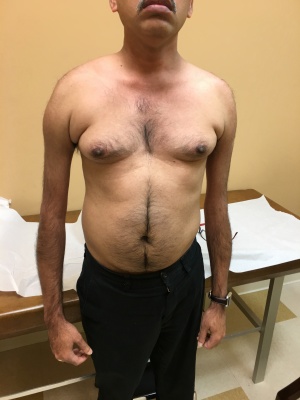Difference between revisions of "Pectoral crease"
From Neurosigns
(Created page with " A pectoral crease is a diagonal groove in the substance of the pectoral muscles running from the anterior axillary fold toward the neck that appears when there is shoulder...") |
|||
| (2 intermediate revisions by 2 users not shown) | |||
| Line 1: | Line 1: | ||
| + | [[File:Pectoral crease.jpg|thumb|Pectoral crease in a patient with FSH muscular dystrophy]]A pectoral crease is a diagonal groove in the substance of the pectoral muscles running from the anterior axillary fold toward the neck that appears when there is shoulder girdle weakness. The usual cause is myopathy, particularly FSH.(1-3) Because of periscapular muscle weakness the scapula slides laterally, causing the arm rotate internally, so that the dorsum of the hand, rather than the thumb, faces forward. When this abnormal internal rotation of the arm and hand occur along with weakness and atrophy of the pectoral muscles the pectoral crease appears. When a patient is standing normally, the back of the hand facing forward and the presence of the pectoral crease are reliable indicators of significant shoulder girdle weakness. | ||
| + | ==References== | ||
| + | 1. Campbell WW. Clinical signs in neurology : a compendium. Philadelphia: Wolters Kluwer Health, 2016. | ||
| − | + | 2. Campbell WW. DeJong's the neurologic examination, 7th ed. Philadelphia: Wolters Kluwer Health/Lippincott Williams & Wilkins, 2013. | |
| − | + | 3. Nelson KR, Bicknell JM. Oblique pectoral crease and "scapular hump" in shoulder contour are signs of trapezius muscle weakness. J Neurol Neurosurg Psychiatry. 1987 Aug;50(8):1082-3. | |
| − | + | [[Category:Motor Signs]] | |
| − | |||
| − | |||
| − | |||
| − | |||
| − | |||
Latest revision as of 00:33, 6 April 2018
A pectoral crease is a diagonal groove in the substance of the pectoral muscles running from the anterior axillary fold toward the neck that appears when there is shoulder girdle weakness. The usual cause is myopathy, particularly FSH.(1-3) Because of periscapular muscle weakness the scapula slides laterally, causing the arm rotate internally, so that the dorsum of the hand, rather than the thumb, faces forward. When this abnormal internal rotation of the arm and hand occur along with weakness and atrophy of the pectoral muscles the pectoral crease appears. When a patient is standing normally, the back of the hand facing forward and the presence of the pectoral crease are reliable indicators of significant shoulder girdle weakness.References
1. Campbell WW. Clinical signs in neurology : a compendium. Philadelphia: Wolters Kluwer Health, 2016.
2. Campbell WW. DeJong's the neurologic examination, 7th ed. Philadelphia: Wolters Kluwer Health/Lippincott Williams & Wilkins, 2013.
3. Nelson KR, Bicknell JM. Oblique pectoral crease and "scapular hump" in shoulder contour are signs of trapezius muscle weakness. J Neurol Neurosurg Psychiatry. 1987 Aug;50(8):1082-3.
